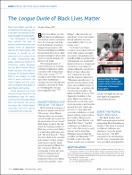Options
The 'Longue Durée' of Black Lives Matter
Date
2016
Author(s)
Nelson, Alondra
DOI
https://doi.org/10.2105/AJPH.2016.303422
Abstract
Black Lives Matter was first articulated just a few years ago, but it has been the leitmotif of antiracist struggles for generations.
The Movement for Black Lives extends the work of previous movements that challenged forms of oppression that act on Black bodies with impunity. It should be understood in the context of Ida B. Wells’ anti-lynching campaign, Fannie Lou Hamer’s reproductive justice demands, and the Black Panther Party’s health activism. The 50th anniversary of the Black Panther Party is an occasion to recall that its work confronted the callous neglect and the corporeal surveillance and abuse of poor Black communities.
Similar demands have been the centrifugal force of social movements that for centuries have refused to have Black lives cast beyond the human boundary.
Black Lives Matter was first articulated as an affirmation, a declaration, and an exclamation just a few years ago, but it has been the leitmotif of antiracist struggles for generations. The Movement for Black Lives (M4BL) bloomed from the seeds of earlier, protracted struggles to attain a full measure of social, political, and physical well-being.
The healing practices of enslaved Africans, for example, challenged a plantation culture concerned with whether their bodies were “sound”(p15–35) enough to labor rather than with their whole healthfulness—a paradox of power described by journalist–activist Ida B. Wells as “dwarf[ing] the soul and preserv[ing] the body”(p75).
The Movement for Black Lives extends the work of previous movements that challenged forms of oppression that act on Black bodies with impunity. It should be understood in the context of Ida B. Wells’ anti-lynching campaign, Fannie Lou Hamer’s reproductive justice demands, and the Black Panther Party’s health activism. The 50th anniversary of the Black Panther Party is an occasion to recall that its work confronted the callous neglect and the corporeal surveillance and abuse of poor Black communities.
Similar demands have been the centrifugal force of social movements that for centuries have refused to have Black lives cast beyond the human boundary.
Black Lives Matter was first articulated as an affirmation, a declaration, and an exclamation just a few years ago, but it has been the leitmotif of antiracist struggles for generations. The Movement for Black Lives (M4BL) bloomed from the seeds of earlier, protracted struggles to attain a full measure of social, political, and physical well-being.
The healing practices of enslaved Africans, for example, challenged a plantation culture concerned with whether their bodies were “sound”(p15–35) enough to labor rather than with their whole healthfulness—a paradox of power described by journalist–activist Ida B. Wells as “dwarf[ing] the soul and preserv[ing] the body”(p75).
Description
Alondra Nelson, coeditor (with Alfredo Morabia), Special Section on The Black Panther Party’s Health Activism, American Journal of Public Health, October 2016.
File(s)
Loading...
Name
Nelson_Longue-Duree_AJPH-Black-Panther-Section_2016.pdf
Description
Special Section on The Black Panther Party’s Health Activism, American Journal of Public Health, October._Pages 1734-1737
Size
589.8 KB
Format
Adobe PDF
Checksum (MD5)
c294010764e12274beb76a8aaae7c6ce